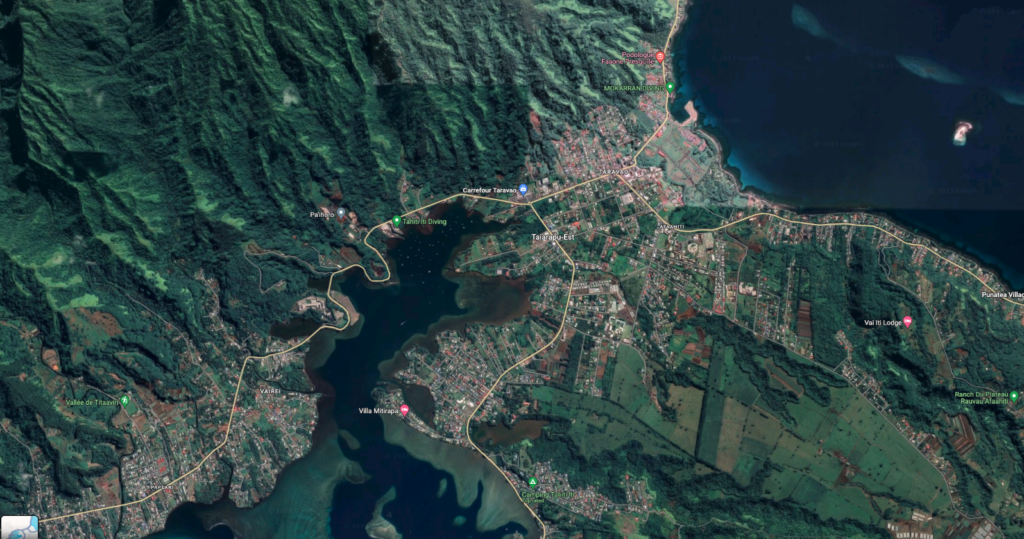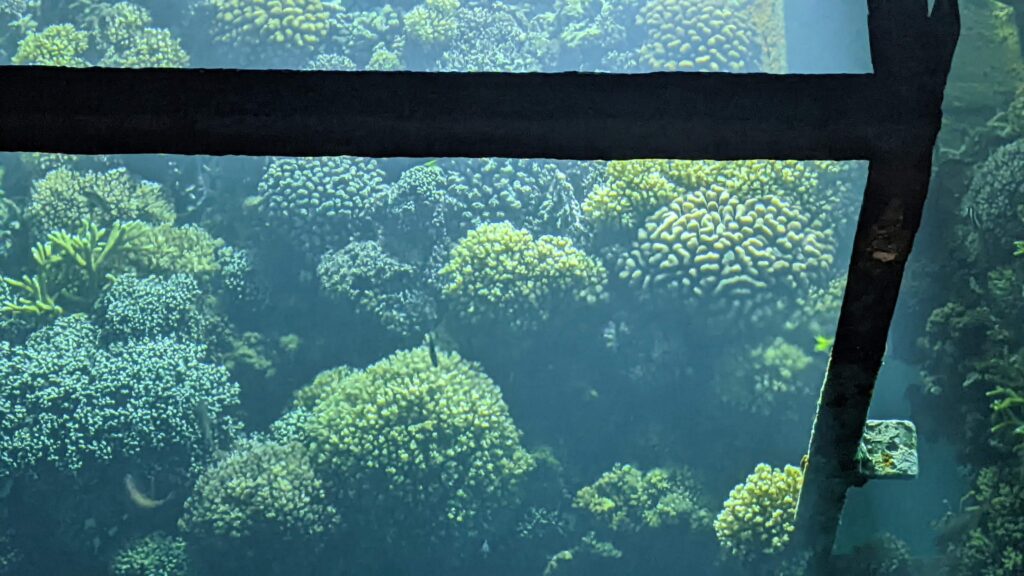Note: These events happened in July 2022 but the post was written in Dec 2023.
Tahiti is a pretty big island so it made sense to start with a day trip in a car to get a sense of the place. Back in Fakarava we had met Hugh, a single-handed sailor who had done the PPJ this year as we did. He was just down the dock from us so we rented the car with him and took off for a day of site-seeing.
Our first stop was Venus Point, the northern most point of the island. Now, time for some history – One of the primary goals of the first voyage of Captain James Cook was to observe the ‘transit of Venus’ when it passed in front of the Sun in 1769. He left England in August 1768 and made landfall in Tahiti in April 1769. His observations were used to help calculate the distance from the earth to the Sun. He then continued his epic exploration and mapping of the South Pacific.
This is also the location from which the HMS Bounty sailed in 1789 just before the crew revolt that was made famous in the “Mutiny On The Bounty.” They had spent 5 months on Tahiti gathering Breadfruit trees which they were to transport to the Caribbean. In their time on Tahiti, quite a few of the men had ‘formed attachments’ to native women and were not too happy to leave Tahiti. I think you know what happened after that… (if not, you really should read the book or see the movie starring Marlon Brando)

Monument to the HMS Bounty
In 1856 a lighthouse was built at Venus Point, with a fixed white light that was visible from 215 miles (really? Wikipedia says so, so it must be true…). It was constructed from coral blocks transported from the Gambier Islands. In WW2 the residents were afraid the Japanese would bomb the lighthouse so they painted it with palm trees and tied palm fronds to the building. It survived the war without damage.

Point Venus lighthouse

Point Venus with lighthouse mostly hidden in the trees.

The bay next to the point is a good anchorage (where the HMS Endeavor and HMS Bounty anchored) and quite safe when the wind is coming from the south or east (which it does most of the time). It has a nice ‘black’ sand beach and very small waves for easy swimming – unless a storm is coming from the north. Then it can get pretty wild.
The island of Tahiti is two old ‘basalt shield’ volcanos connected by a narrow isthmus. The larger part is Tahiti Nui, with Tahiti Iti being the smaller.

We drove clockwise around Tahiti Nui to the isthmus and then went down the southwest side of Tahiti Nui to Teahupoo which is a world-famous big-wave surfing location. It is said to have the ‘heaviest’ wave in the world, meaning that the volume of water that crashes down when it breaks is thicker and heavier than anywhere else.

The break at Teahupoo (not my photo)
For a video showing the awesome power of this wave click here.
It is an incredibly dangerous place to surf because many areas are over very sharp coral that is just a couple feet below the water. There have been a number of deaths surfing this monster wave. This also happens to be where the 2024 Summer Olympics surfing events will be (kinda odd with this being the ‘Paris Olympics,’ but this is French Polynesia.)
Peggy and I thought we’d give it a try so we jumped on a board and caught the wave.

Peggy surfing a big one! 😉

Pat riding a monster wave!
There is a small community of homes at Teahupoo. It is very quiet and sleepy until the Billabong Pro Tahiti surf competition which is part of the World Championship Tour every year. Then the town explodes with surfers, TV crews, journalists and fans. Thankfully, it was slow and quiet when we were there.

Teahupoo when the surf tour is NOT in town.

Coming back up the southwest side of Tahiti Iti (the road ends after Teahupoo) we stopped at a very well protected anchorage tucked in at the isthmus where Hugh was thinking of leaving his boat when he flew back to the states.

The small dots are boats in the protected anchorage.
Heading around the south side of Tahiti Nui, we stopped at the Gaugain Museum where the artist used to live but it appeared to have closed for some years (it was open when I visited in 2016).
Heading further around, we stopped at the Vaipahi Water Gardens.



A bit further along was Grottes De Mara’a, a cave with water dripping down into a pool. With this being a volcanic island, there are a number of ‘lava tube’ caves like this.

We finished the day by inviting Hugh to Calista for dinner. He is a retired microbiology professor from the University of Illinois and from South Africa before that. He is doing a single-handed circumnavigation and he has many great stories. He is also an avid kite-boarder and taught his daughter to kite-board when she visited him in Fakarava.
The next day was back to boat chores. We have two electric winches at the helm and the motor on the port side winch had decided to quit working a couple weeks earlier. Pulling the winch out was no easy task. It had to be done from inside the salon, first removing a set of cabinets in the galley and then doing contortions to get the wrench up into the tight spaces where the nuts hold it in place.

Bottom of the winch looking straight up. The metal cylinder on the right is the non-working motor.
After some skinned knuckles and inventing some new expletives, I was able to pull it out. Papeete is a large enough place that it has a number of shops capable of repairing winches so I went off to ENIPAC. Their english was not great, but they knew winches and had it working in a couple days. Putting it back in was even harder, lifting it up into the ceiling and keeping it in place while reseating the bolts. Peggy & I were both up on the countertop in the galley working this.
We also did some repair work on one of the kayaks. Not so smart, I had left it tied by it’s carry-handles on the front trampoline. We hit some heavy seas on the passage from Rangiroa and the waves tore the handle right off one end, putting big tears in the kayak’s outer fabric. Waves are strong. Don’t mess with them.
In town, we found a favorite pastry shop and often stopped by for a croissant and cappuccino. There is also a craft-brewery that serves a 5 glass sampler and a number of nice resaurants.

A great place for lunch or dinner, just a two minute walk from our marina.

There is a long, narrow park along the water, next to our marina.

Free concert in the park, sponsored by Nescafe.

A masterfully built traditional Polynesian catamaran. Some of these were over 70 ft long and could tranport 100 people thousands of miles. These were used to settle Hawaii, probably from Bora Bora, a distance of 2,600 miles!

Downtown park with Moorea in the background.

Along the main seawall at the marina is a project growing new coral that is periodically moved out to restart coral colonies that have died due to pollution, bleaching (when the water is too hot the coral dies and turns white) or just general abuse. They light it up at night and it is really pretty to watch as you are walking down the sidewalk.
One day we took a bus up one of the valleys for a beautiful hike.

Creek hike up Fautaua Valley.

There was even a nice swimming hole at the top of the hike.
Several more days with some boat chores and some exploring Papeete, and suddenly it was time to fly back to San Diego. By early August we were both back home with Calista tied up in Marina Papeete. When you leave a boat unattended, the marina requires you to hire someone to watch the boat. We talked to two guys, both highly recommended and chose Gilles Haudrechy, a frenchman now living in Papeete. He has been doing a GREAT job of looking after Calista, running the engines and generator once a week, checking the bilges, flushing the toilets and (critically) watching the lines and fenders for any signs of wear. We feel very comfortable having Gilles watching Calista.